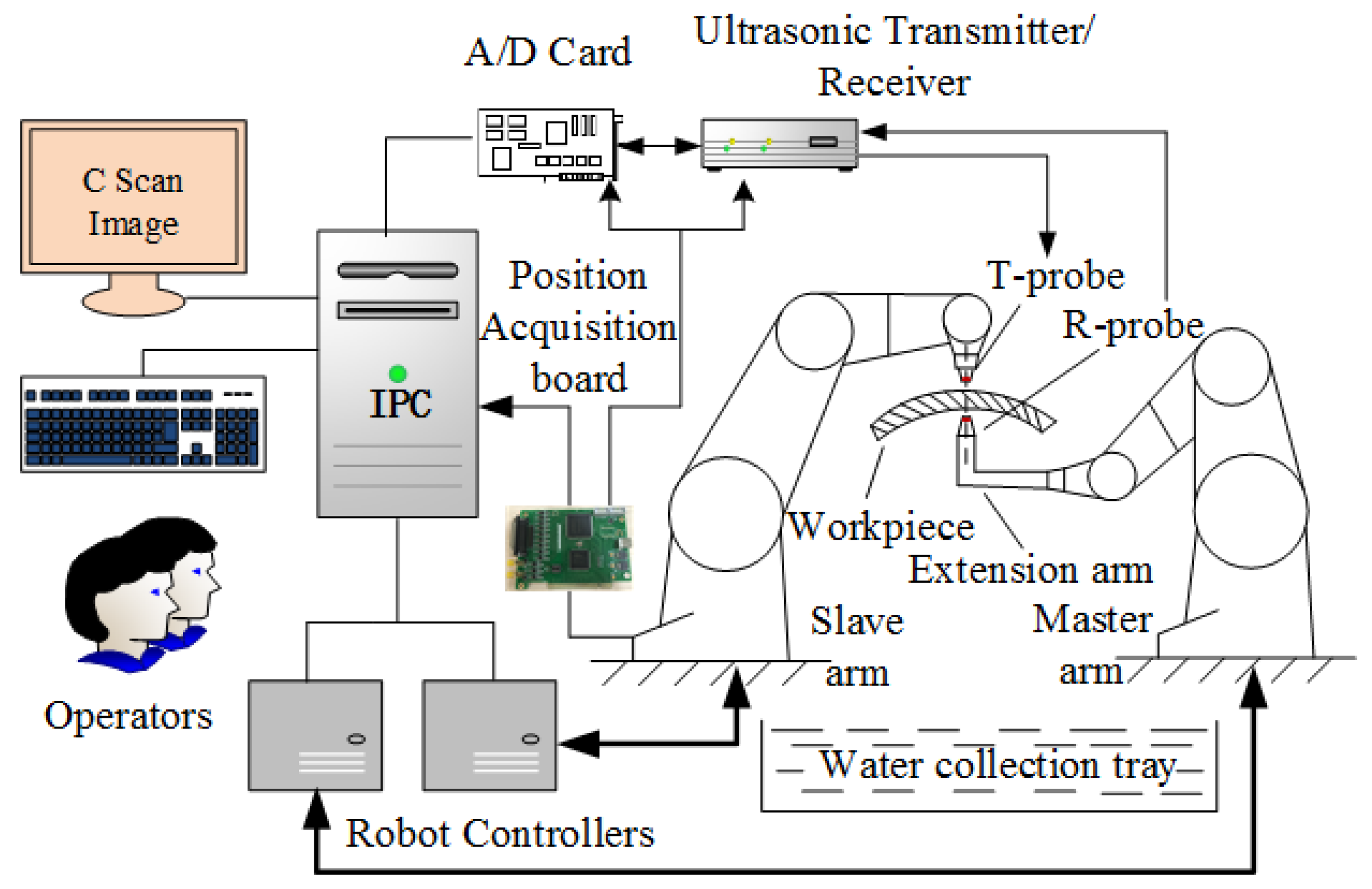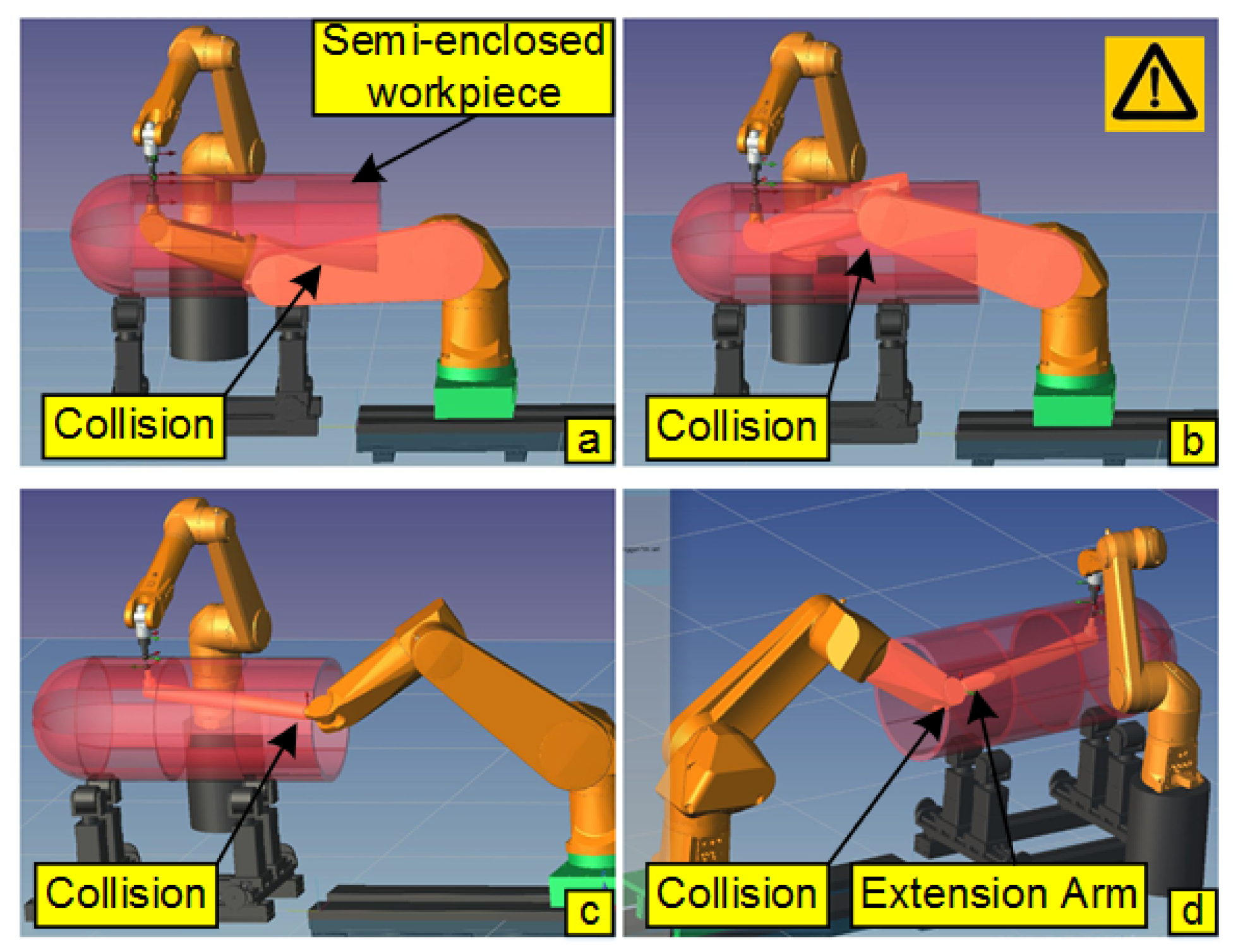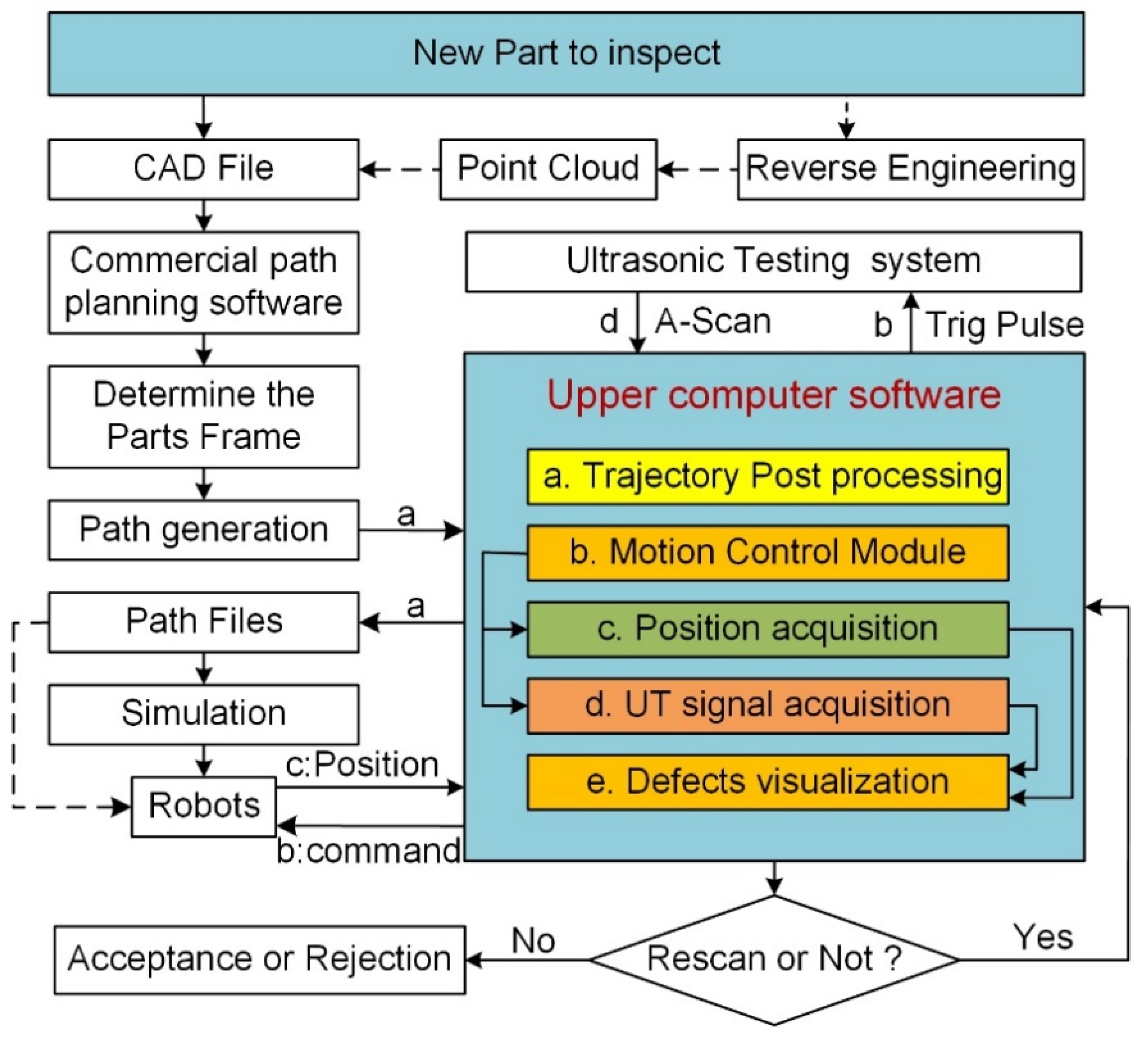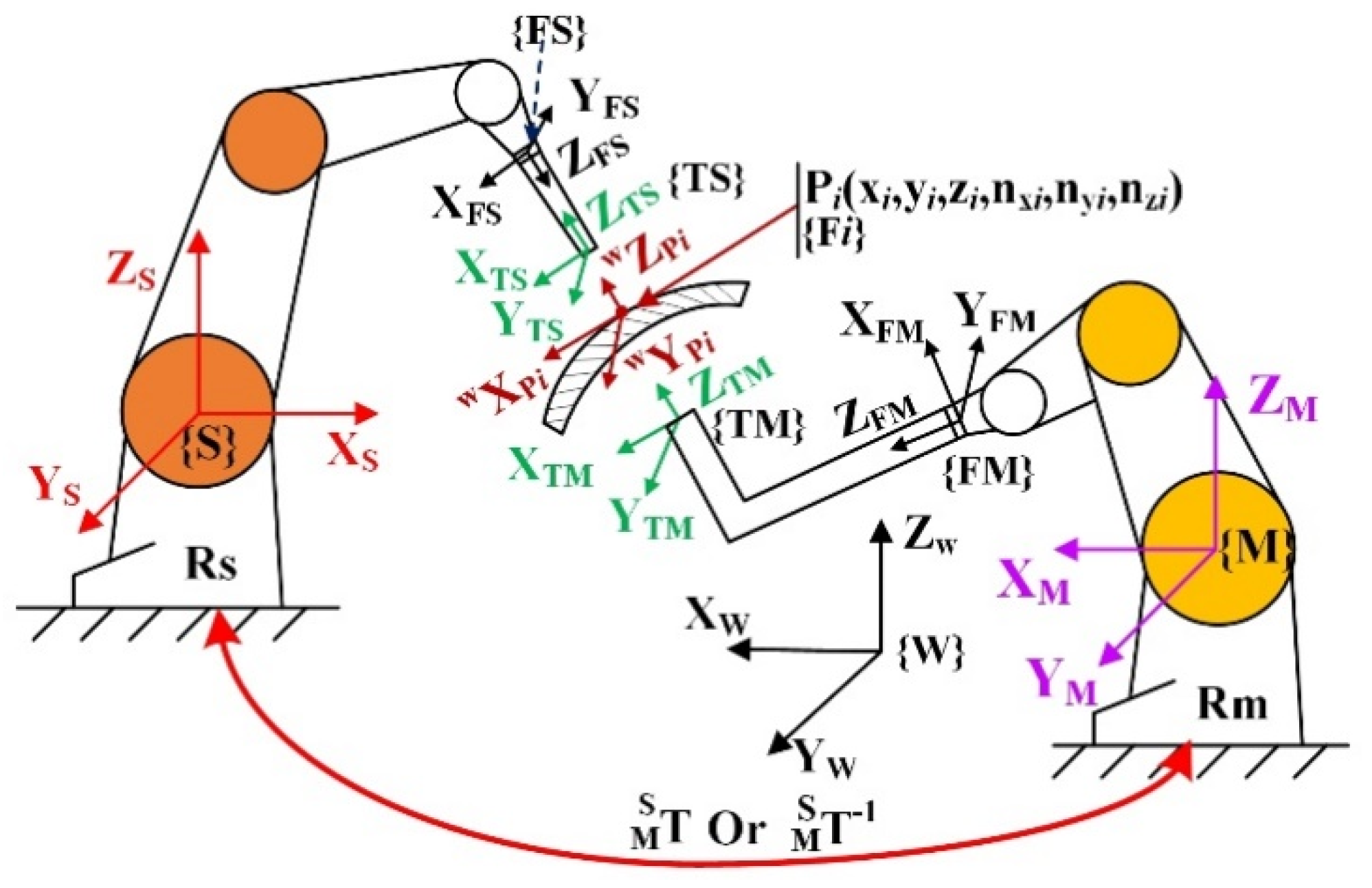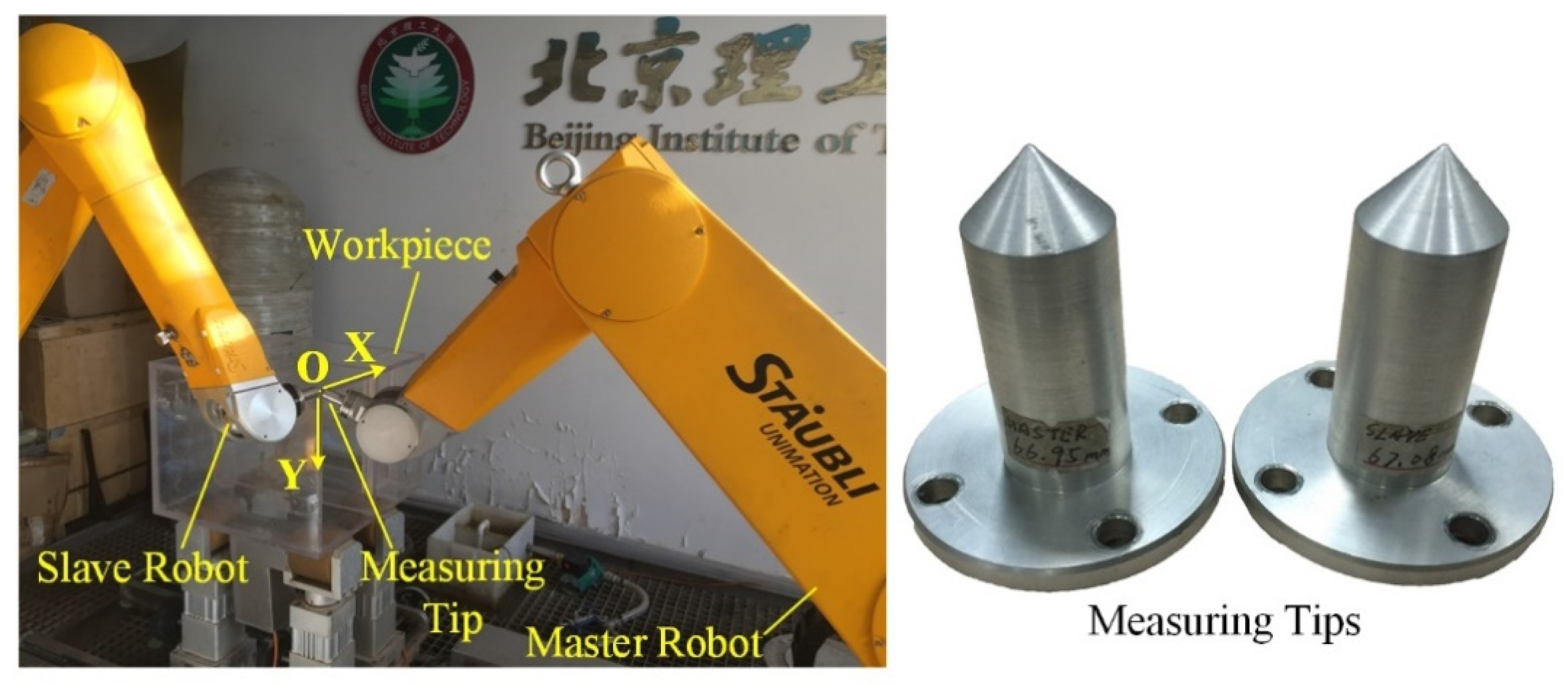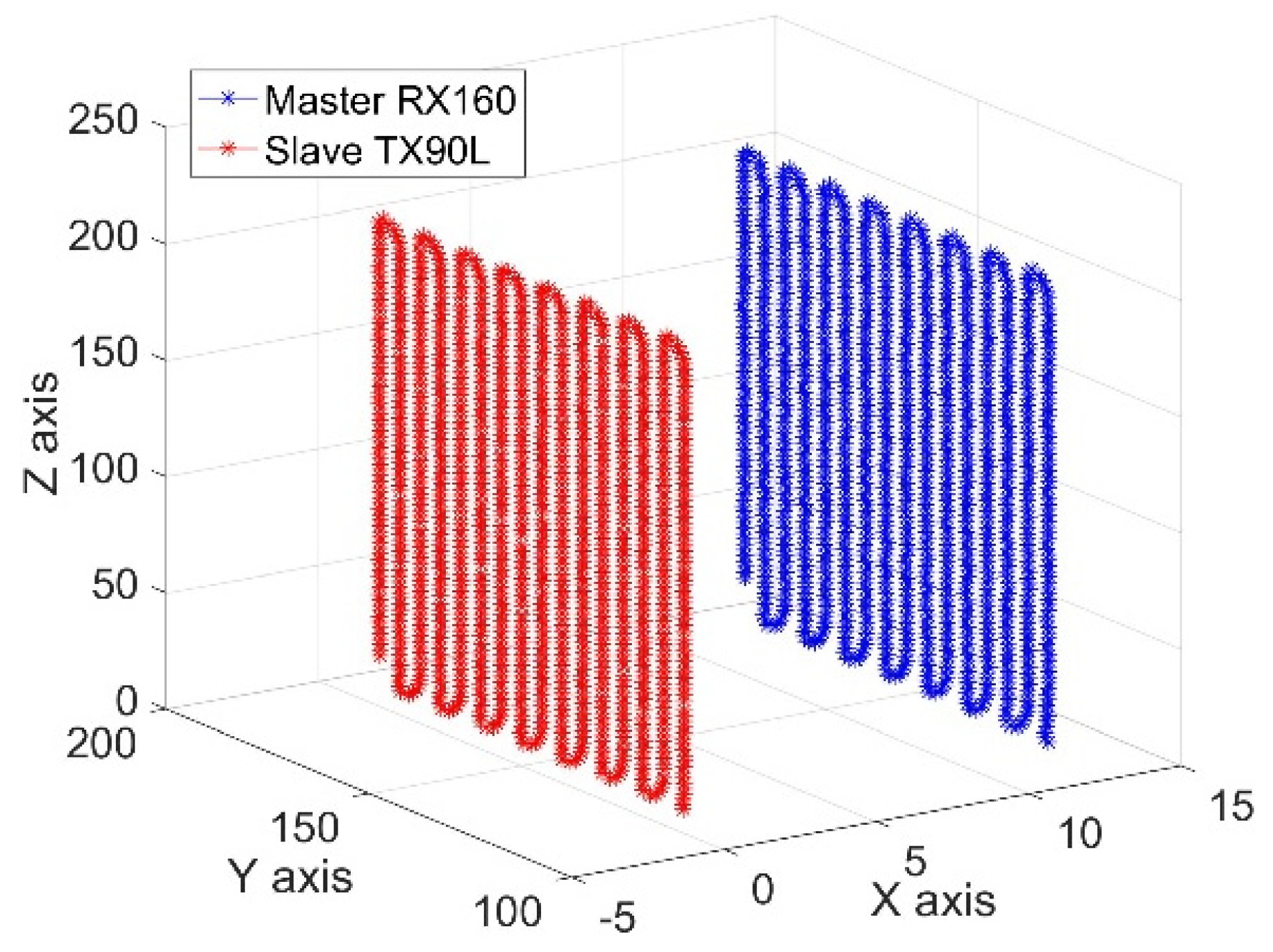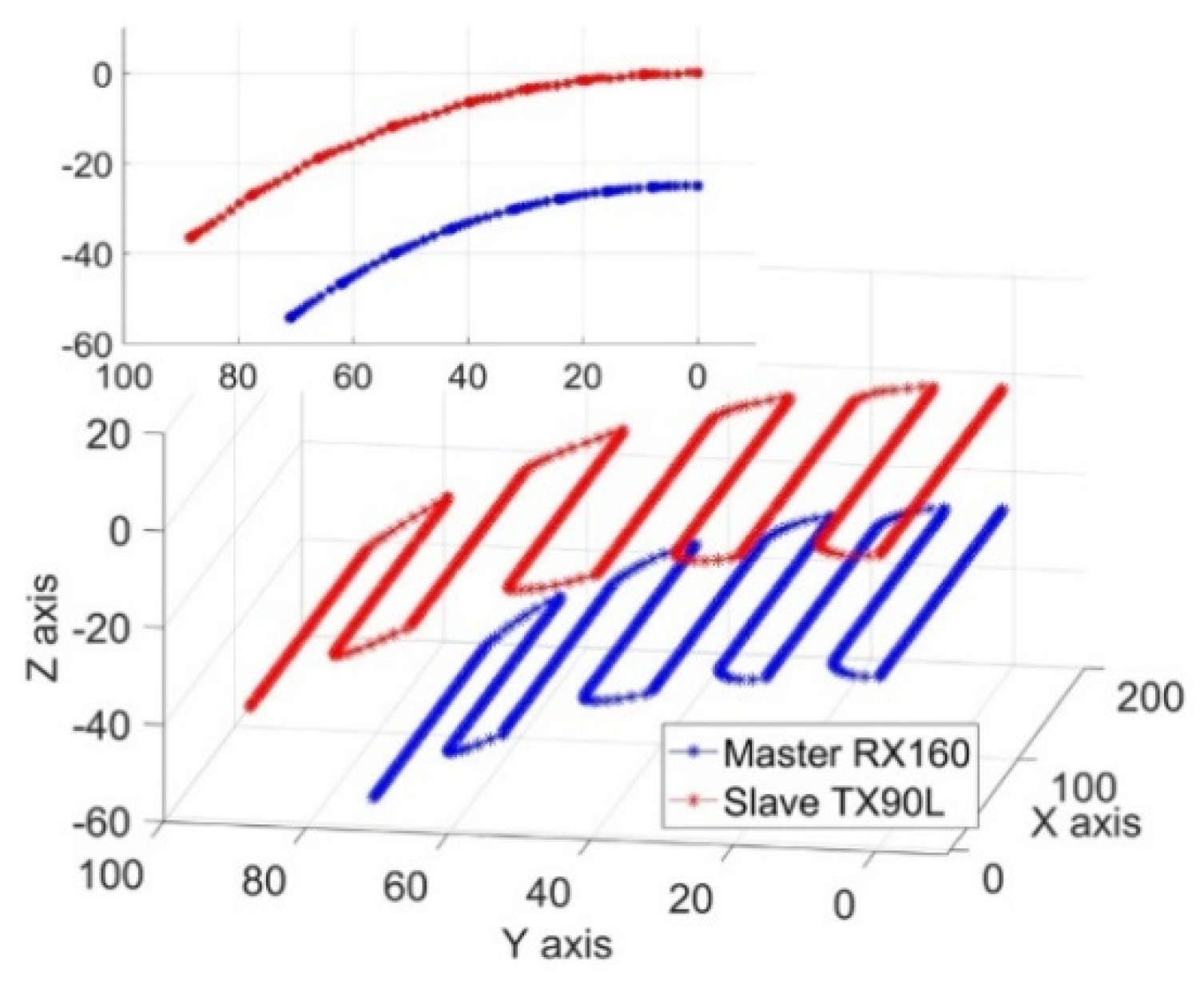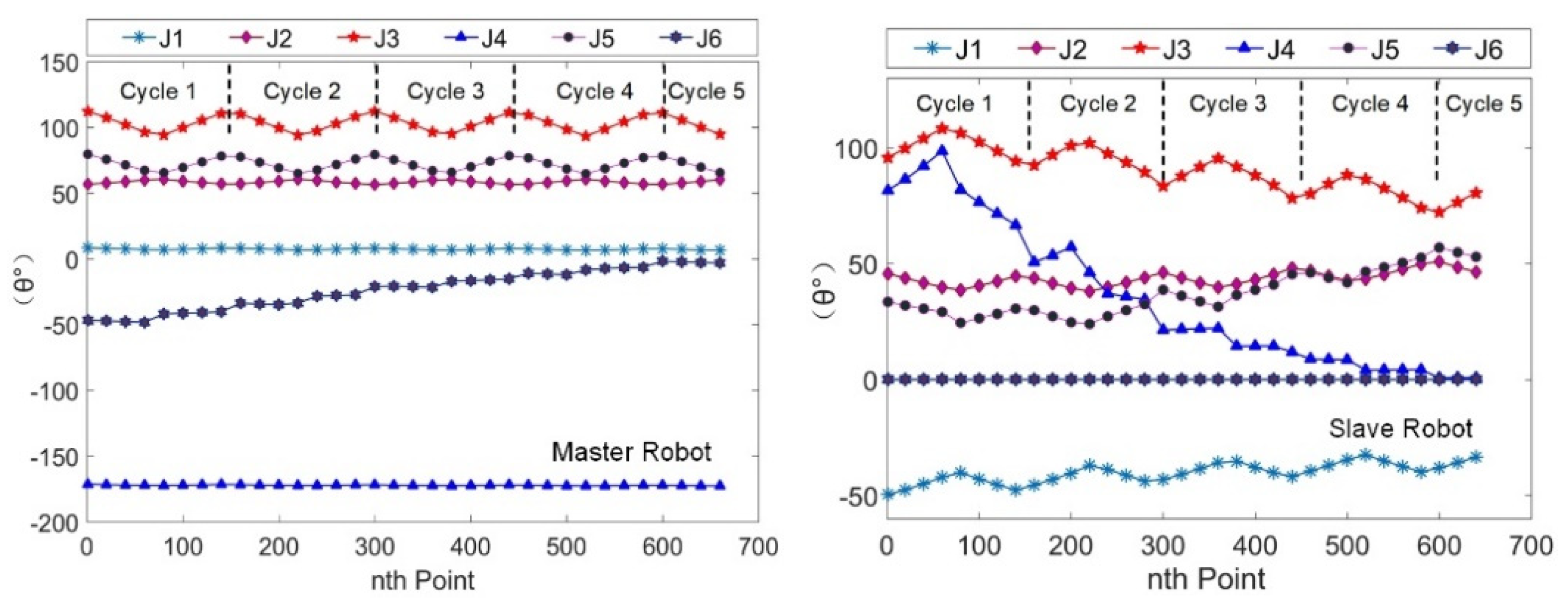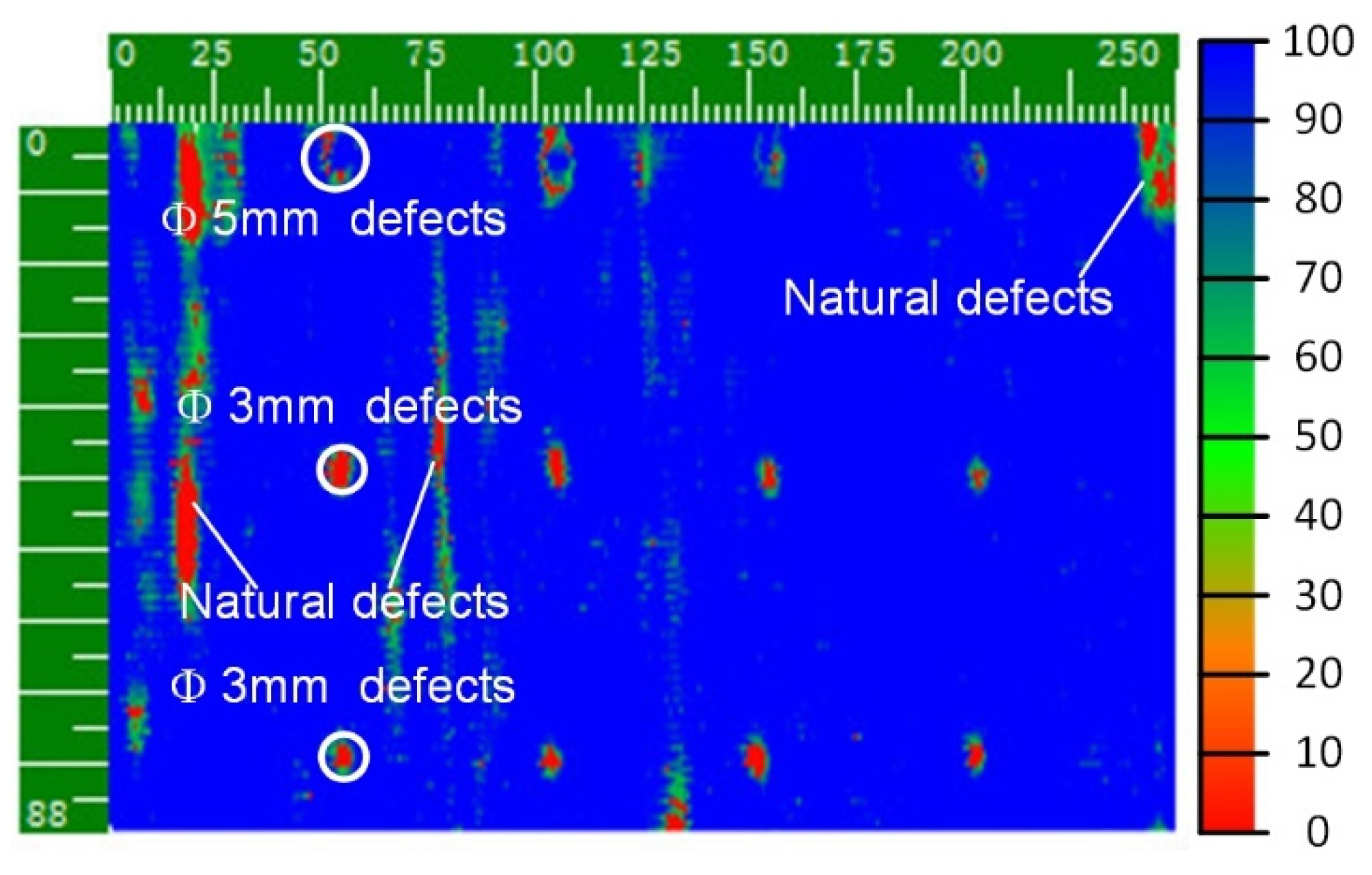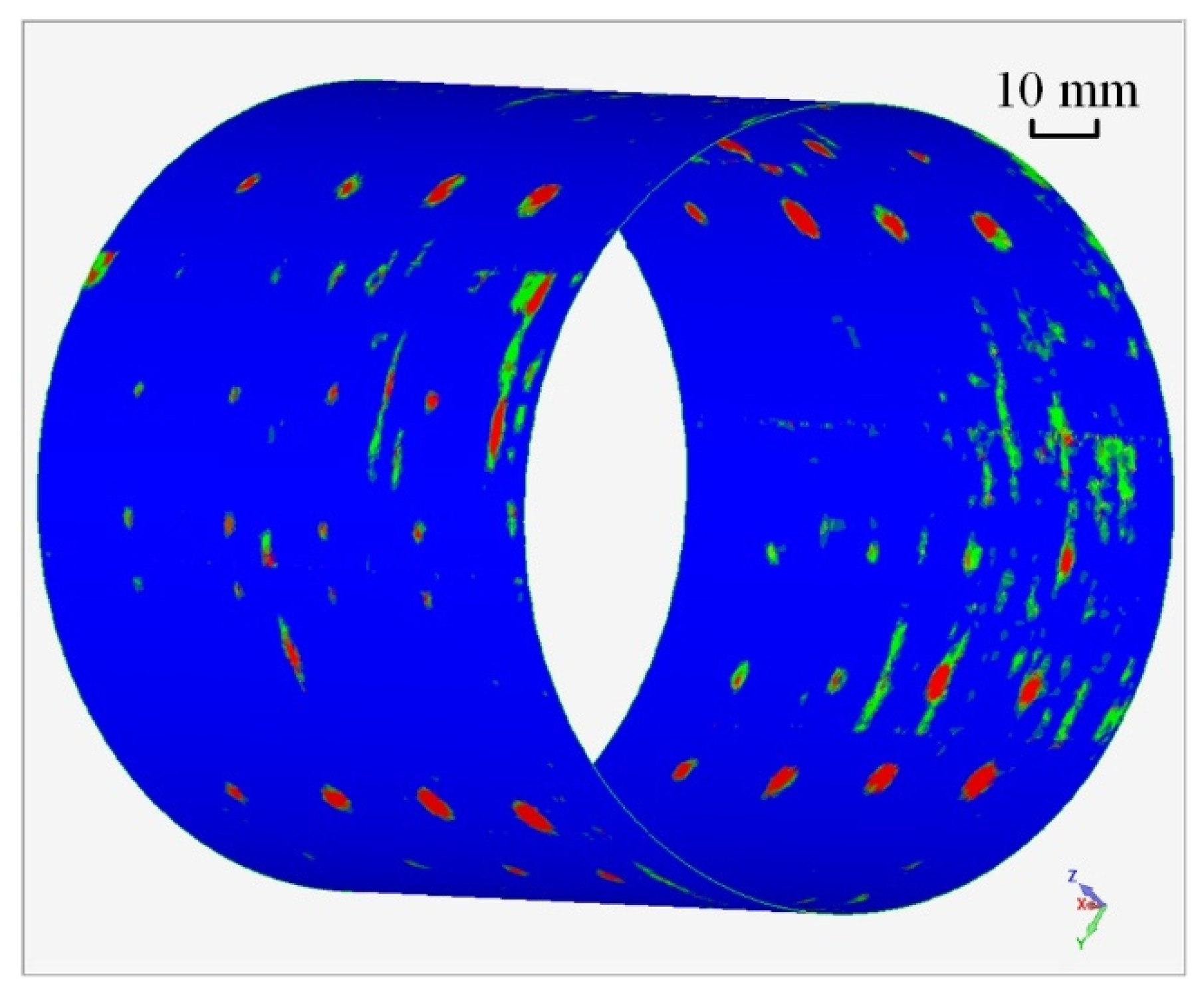1. Introduction
It is well-known that composite materials are used in various industries, especially in aviation and aerospace industries, due to the desire to avoid corrosion, to enhance impact and fatigue resistance, and to develop lighter structures [
1]. The qualities of composite components are critical to life safety, so the integrity of these components has become a core problem that engineers are very concerned about. Non-destructive testing (NDT) techniques are used to inspect internal and surface defects such as cracks, voids, porosity, inclusions, and corrosion [
2]. Previously, the time-consuming, laborious manual testing method has been commonly used for these workpieces, which has provided motivation to develop automated NDT equipment for these components. Some NDT techniques, such as ultrasonic testing (UT), eddy currents testing (ECT), and radiography testing (RT), can be readily automated by the use of wheeled, climbing, crawling, or joint-type industrial robots [
2].
In recent years, research regarding robotic NDT technology and its relative equipment has been very active. Sattar and Brenner proposed a position-force-moment (PFM) feedback method which adapted a seven-axis robot arm to scan a complex-shaped part by keeping the NDT probe perpendicular to the surface and maintaining a constant contact force with the part surfaces [
3]. However, in order to maintain high reliability, the system must reduce the detection speed. Xiao [
4,
5] established an NDT system in which the probe was fixed and the workpiece was grasped by the robot for movement. This system is well-suited for the high-speed automatic testing of small complex-shaped parts, such as aircraft engine blades. From his research results, he also showed a method to calibrate the end effector orientation using the ultrasonic alignment method, in order for the robot to adjust the orientation of the tool frame to keep the probe perpendicular to the surface. Further, for large curved rotators, such as wheel hubs, Zhang [
6] developed another robot-assisted UT system and in order to improve the inspection sensitivity, the focus depth of the ultrasonic beam was optimized.
Although the robotic NDT method has many merits compared with those of other NDT methods, sometimes a system with only a single industrial robot is not sufficient to inspect complex curved composite parts with s high ultrasonic attenuation rate, such as carbon fiber materials. In this case, the importance of the dual-robot NDT system is highlighted. Maurer concluded that the dual-robot automatic scanning system became increasingly used to inspect carbon fiber parts, such as aircraft fuselages [
7]. For multi-robot systems, the relationships between various coordinate frames are very important. Lu presented a simple “THREE POINTS” method for synchronizing the part frames of a dual-robot cell in NDT systems [
8]. Cooper [
9] and Mineo [
1] established a twin-robot NDT system with a simple-to-use graphical user interface (GUI) to control all aspects of the automatic inspection, from the trajectory data loading to the scanning data analysis. The system could also control the robot to return to the points of interest (the points are probably defects), which greatly increased the practical usefulness of the inspection system. In order to perform non-destructive testing of complex curved workpieces, Mineo developed flexible trajectory planning software for manipulators in NDT systems based on the MATLAB toolbox [
10]. He also designed a customized instrument, referred to as FIToolbox, to enable high speed analogue acquisition [
11]. This was a major advancement in the area of robotic ultrasonic NDT. For the inspection of workpieces with variable thicknesses, Lu [
12] proposed a kinematic constraint method between two robots; this method guaranteed that the transmitting transducer was in the normal direction of the incident surface and the receiving transducer was in the sound beam propagation path. Morozov [
13] introduced a practical off-line trajectory planning method based on reverse engineering for an unknown model. Guo [
14] established a dual-robotic NDT system and presented a four-posture calibration method to calibrate irregular-shaped tools used for complex workpiece testing. Simultaneously, he also proposed another method for aligning the two probes completely during the inspection of the dual-robotic NDT system, which was called the tangential constraint method [
15]. In the aspect of multi-axis motion control, Rodriguez-Angeles [
16], Sun [
17], and Shang [
18] proposed a synchronizing controller, a model-free cross-coupled controller, and a task-space coordination controller, respectively, for multi-axis motions. They showed good performance in reducing synchronization errors.
Despite these abundant and accessible documents, the composition and workflow of the dual robot system and the detailed NDT methods for semi-enclosed workpieces have not been described. The crucial challenges include the generation of usable trajectories for complex curved workpiece surfaces, real-time compensation of movement trajectory, and fast data processing. This paper establishes a dual-robot NDT system (DRNDT) for the inspection of semi-enclosed workpieces and presents a specific trajectory planning approach for the NDT scheme to inspect these workpieces. The paper is structured as follows.
Section 2 introduces the NDT method of the semi-enclosed workpieces and the composition and working principle of the DRNDT system. A custom trajectory planning method for semi-enclosed workpieces inspection is introduced in
Section 3. Verification experiments of the trajectory planning method and ultrasonic testing experiments of a rectangular semi-enclosed box and a cylindrical workpiece are presented in
Section 4 and
Section 5. The conclusions are provided in
Section 6.
2. Scheme of the DRNDT System
2.1. Architecture of the Dual-Robot NDT System
The DRNDT system is characterized by multiple degrees of freedom, good flexibility, and a wide range of applications. The architecture of the system is shown in
Figure 1. One of the robots held an extended irregular-shaped arm to move in the interior space of a semi-enclosed workpiece for NDT.
This may be the best way to inspect this type of parts. The extension arm was fitted with appropriate constraints to prevent the risk of collision. Typical collision accidents of the DRNDT system with or without an extension arm are shown in
Figure 2.
Figure 2a,b show the collisions between the robot and the semi-enclosed workpiece when an extension arm was not deployed on the robot.
Figure 2c,d show the collisions between the robot (or extension arm) and the semi-enclosed workpiece when an extension arm was mounted on the robot. In order to ensure that the system performs NDT of the semi-enclosed workpiece without collision, a coordinate frame constraint method and corresponding special post-processing method of trajectory were proposed. Details of the method are explained in
Section 3.
For easier control of the entire system, a well-functioning upper computer software was also developed for this system.
Figure 3 provides the schematic diagram of the overall inspection process, including the interactions between the software and each module. This matching software coded with C# programming language was developed, which integrated all the modules that were needed during the testing process, such as trajectory post processing (module a), motion control (module b), position and ultrasonic data collection (module c and d), and results visualization (C-scan image, module e).
The main operation steps of this system were as follows. First, the 3D model of a workpiece through CAD (Computer Aided Design) files or reverse engineering was obtained. Second, the initial trajectory through commercial CAM (Computer Aided Manufacturing) software such as Dassault DelmiaV5 R20 was planned. Third, post-processing of the trajectory through the upper computer software was performed and the final trajectory files were generated (process “a” of the software in the scheme of
Figure 3). Fourth, motion simulation was performed and the trajectory data files were downloaded to the robot controller if there was no risk of collision. Finally, the real machine experiment began and all inspecting processes were controlled by the upper computer software, including the starting and stopping of the motion system and the ultrasonic system simultaneously, ultrasonic data and position data collection synchronously (processes “b”, “c”, and “d”), and defect visualization. In the testing process, once the robot motion was activated, the acquisition module collected position data and the corresponding ultrasonic data at every trajectory increment. Once the data was collected, it was sent to the upper computer software for processing, analysis, and C-scan image display. The realization of the position-driven data acquisition was based on a high-speed robot position acquisition board developed in our laboratory.
This board guarantees a high-speed acquisition of position data and breaks the limitation of the low acquisition rate due to the long system cycles of the robot controller (STAUBLI, a robot brand, robot’s system cycle is often 4 ms). Its highest position acquisition rate can reach 10 kHz and it can obtain position data with an interval of 0.1 mm. When the robot moves, the acquisition board sends position data at a specified trajectory increment and a trigger pulse to trigger ultrasonic data acquisition. This ensures that the position data and ultrasound data are collected at the same time. These well-synchronized position and ultrasonic data further produce good quality 2D and 3D C-scan images.
2.2. Coordinate Frames in the Dual-Robot NDT System
The key to synchronizing the motion of two robots is that any point in space is mapped into the two robot base frames. Therefore, the definition of the coordinate frames in the DRNDT system should be explained in advance. As shown in
Figure 4. Frame {
} is the frame of the discrete point
on the planning trajectory, called the auxiliary discrete point frame. The expressions of
in frames {
} and {
} are
and
.
is the rotation matrix that implies the transformation relationship of frame {
} relative to frame {
}.
To coordinate the movement of the two robots, the coordinates of the testing points on the surface of the workpiece and their normal directions should be known for each robot’s base frame (i.e., {} and {}). Usually, coordinate transformations from workpiece frame to robotic base frames are needed, because the discrete points on the trajectory are expressed in frame {}, rather than expressed in the robotic base frames. If is known, we can map any point relative to one robotic base frame into the other robotic base frame according to the coordinate transformation theory. In addition, it should be noted that the frame rotation sequence of the robot used in this paper follows the X-Y-Z Euler angle setting convention.
2.3. Method to Calibrate the Transformation Relationship of Frame {M} and Frame {S}
In robotics, a vector is often used to describe coordinate and orientation. It is assumed that there are four non-coplanar points in the communal workspace of the two robots. Their descriptions in frame {
} are
and in frame {
} are
(
). According to coordinate conversion theory, the translation equation is
where
.
Expanding Equation (1), yield
If the four points,
,
,
, and
, are selected in such way that the vectors formed by any two points of them are linearly independent, in other words,
, Equation (2) has a unique solution, i.e.,
The translation matrix can be determined experimentally. The robots holding the measuring tip move to the four selected points respectively to record the coordinates
and
of the four points. Then, the matrix
between the two robots can be determined with Equation (3). More profoundly,
is composed of a rotation matrix (
) and a translation vector (
).
is the representation of the base point of frame {
} relative to frame {
}.
If the rotation matrix
does not meet the constraint of orthogonal normalization, it can be normalized orthogonally using the matrix orthonormalization method presented by Lu [
8] to normalize the rotation matrix.
2.4. Method to Calibrate the Transformation Relationships of a Workpiece Frame Relative to Robotic Base Frames
The transformation relationships between a workpiece frame {} and robotic base frames {}/{} are the basis of the simultaneous movement of the two robots and other robotic work cells. The relationships between them can be determined by calibrating three points on the part using the robots holding measuring tips. These three points are determined as follows:
- (1)
Point ( determines the base point of frame {};
- (2)
Point () determines the X-axis of the frame {} and the X-axis direction;
- (3)
Point () determines the XOY plane of the frame {}.
These three points are denoted as
{
},
{
}, and
{
} relative to frame {
} and
{
},
{
}, and
{
} relative to frame {
}. A typical calibration process of a workpiece frame is shown in
Figure 5.
The transformation matrixes between frame {} and the robotic base frames {}/{} can be obtained through the following specific calculation.
The unit vector
of
x,
y,
z components of frame {
} relative to frame {
} can be expressed with the coordinates of the three selected points relative to frame {
}. The calculation method is as follows.
where
is an arbitrary vector on the XOY plane point to the positive direction of Y-axis of frame {
}.
The transformation relationships of frame {
} relative to frame {
}/{
} are shown in Equations (6) and (7), respectively.
Another method to determine the relationships between a workpiece frame and the robotic base frames are to first determine the relationship relative to one robot by using one of the robots to calibrate the three points of the workpiece frame, then determine the relationship of the workpiece frame relative to another robotic base frame according to Equation (4). According to the matrix transformation theory, the equations for calculating the relationships of frame {
} relative to frame {
}/{
} by this method are as follows.
This method of determining the relationships between workpiece frame and the two robotic base frames has two merits. One is that when one robot of the two robots cannot reach the selected three points, the two relationships can still be determined. The second advantage is that this method saves almost half the time used in previous workpiece frame calibration methods.
3. Trajectory Planning Approach for Inspecting Semi-Enclosed Workpieces in a DRNDT System
Nowadays, the offline trajectory planning method, which utilizes a 3D CAD model of a part to generate a tool path based on CAM software, is becoming more and more popular. It is more efficient and provides certain flexibility to the changes of products to testing [
19].
Although it is expedient to generate a good raster scan trajectory for NDT probes as demonstrated by
Section 2.1, if the trajectory path is generated by a customized software developed for 5-axis machine tool rather than for robot NDT system, post-processing is essential before applying the trajectory to the 6-axis robot NDT system [
20]. One set of trajectory data generated for machine tool is [
x,
y,
z,
,
,
], which is composed of position parameters
x,
y,
z and unit normal vectors
,
,
.
According to the principle of conventional ultrasonic testing, the ultrasonic beam should be perpendicular to the surface of the workpiece in real time during the inspection. The principle of motion control of an industrial robot is to completely align the tool frames {
}/{
} with the auxiliary discrete point frame {
} (refer to
Figure 4).
To ensure the robots move in correct positions and orientations and do not collide with the workpiece, an algorithm is proposed to establish the auxiliary discrete frames for trajectory points (
), called the X-axis constraint method. In addition, in order to completely constrain the orientations of the robotic end effectors, it is an indispensable step to convert the normal vectors (vector direction cosines) of the discrete points to Euler angles relative to the frame {
} according to the X-Y-Z Euler angle principle, as shown in
Figure 6.
According to the X-axis constraint method, the X axes of all discrete points frames {
} are defined as the direction of the initial motion (point from the first point to the next point; the adjacent line points to the previous point from the current point) and tangent to the trajectory. Z-axis directions of discrete point frames take the directions of the outer normal vectors of the surface at the discrete points. The Y-axis is automatically obtained by the cross product of
and
. The disadvantage of this method is that when the trajectory is not a straight line, the X-axis is not the tangential line of the trajectory and needs to be corrected. This is shown in
Figure 7.
The specific method is as follows.
The X-axis of the initial discrete point frame is named virtual
denoted by
:
The Z-axis of the discrete point frame is the tool axis vector, i.e.,
The Y-axis of the discrete point frame is the cross product of
and
:
The real X-axis denoted by
is corrected by the cross product of
and
, i.e.,
The combination of these vectors constitutes the rotation matrix
of the discrete point frame {
} relative to the workpiece frame {
}.
In Equation (14), the first column represents the projection of the X-axis of frame {} in the workpiece frame, the second column represents the projection of the Y-axis of frame {} in the workpiece frame, and the third column represents the projection of the Z-axis of frame {} in the workpiece frame.
In order to ensure the smooth movement of the robots during the detection process and no risk of collision, all the X-axis directions of the discrete point frames are constrained according to the X-axis constraint method. In this way, it is possible to ensure that the robots inspect the entire workpiece with a slight change in orientation.
According to robotics, the rotation matrix
is expressed by Euler angles, as follows:
where
,
, and
are the Euler angles that represent the rotation angles of the discrete point frame relative to the workpiece frame in the order of X-Y-Z.
and
are abbreviated to
and
for clarity.
has a unit of degree, i.e.,
By Equation (16), we have
In Equation (17), the positive value is used. In other words, the value range of
is set to (−90, 90), i.e.,
If
, the matrix
is reduced to
Then,
is taken as 0, so we have
The trajectory data prepared from the CAM software is post-processed using Equation (10)–(21). The constrictions adopted in the algorithm allow the system to perform NDT of semi-enclosed workpieces smoothly.
6. Conclusions
To cope with the NDT challenge of semi-enclosed workpieces, a dual-robot-based ultrasonic NDT system scheme was proposed. The coordinate frames and coordinate transformation method related to the cooperative motion control of the dual-robot system were discussed. A trajectory planning approach for inspecting semi-enclosed workpieces in DRNDT system was studied and an X-axis constraint method was proposed to process the trajectory data generated by CAM software. An auxiliary coordinate frame was established at each discrete trajectory point according to this method to minimize the orientation change of the robotic tools during the whole detection process.
The trajectory validation experiments were implemented so that the two robots moved smoothly and no collisions occurred when the robots moved in the trajectory. This was processed by the X-axis constraint method.
Ultrasonic C-scan testing experiments utilizing the optimal water path distance, about 58–70 mm, determined by simulation result of a multi-Gaussian beam model, were carried out on a rectangular semi-enclosed box-shaped workpiece and on a cylindrical workpiece. All the obtained C-scan images clearly presented not only the artificial defects, but also the natural defects. Further, for the rectangular semi-enclosed box, due to the bubbles and small wrinkles between the tape and the workpiece, some irregular-shaped defects also emerged on the C-scan image. In addition, the clear red triangle on the C-scan image illustrated that the DRNDT system had a very good ability to restore the triangular defects. For the cylindrical workpiece, since the material that filled in the hole-shaped artificial defects sank into the bottoms of the holes, the performance of the artificial defects was invalid. Therefore, the centers of the 5 mm artificial defects in the C-scan image were not highly discriminating. The detection results of the two rows of 3 mm artificial defects showed that the system had the same detection resolution for defects in different positions of space. Finally, the 3D C-scan images made the testing results clearer and more vivid.
According to the above analysis, a dual-robot NDT system with one robot equipping an extension arm is suitable for the NDT of semi-enclosed workpieces.
